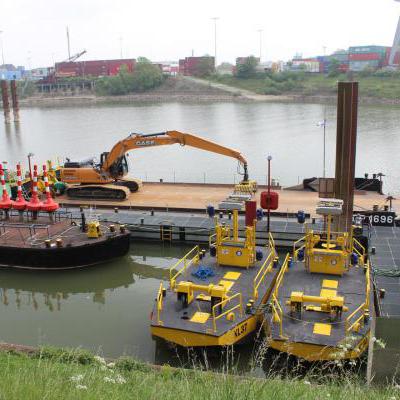Dredger (Baggermeester)
Information on this skill...
A dredger is responsible for dredging work, which can be carried out with self-propelled or stationery material. Self-propelled material relates, for example, to trailing suction hopper dredgers. Trailing suction hopper dredgers can suck up dredged material while sailing and then discharge it on location. As a dredger, you work within hydraulic engineering, which has various professions. In addition to dredging work, the dredger is usually responsible for minor maintenance and repairs, which must be carried out on board the dredger or on the dredging material. Dredging work can be carried out on inland waterways and at sea (offshore). Offshore usually relates to coastal and riparian works. Nowadays, a dredger often works with computers to be able to dredge and unload at the right location. A dredger usually works from the control house or works on the bridge. The dredger is usually the captain on board a ship and can lead other employees, such as dump workers. As a dredger, depending on the employer, it regularly happens that you work abroad. The profession of dredger must be seen as fairly general because not all dredgers work with self-propelled material. It is therefore not the case that a dredger works on a dredger in all cases. The classic dredger usually works on a dredger, which can relate to inland vessels and seagoing vessels. In all cases, the dredging sector does relate to hydraulic engineering. The work of a dredging master can be regarded as important work because the dredging of sludge is important for various reasons.
Dredging work can be carried out for various reasons. Think, for example, of inland waterways that slowly silt up due to silt and sand, so that inland vessels can no longer sail at low tide. If ships can no longer use the rivers because they silt up, ;economic damage will occur. Rivers are also called waterways because they are often used to transport goods and people. Offshore dredging work usually involves coastal work, such as spraying a beach or dunes. Beaches and dunes are slowly crumbled by weather influences and therefore need to be maintained. It is also possible that dunes need to be raised and strengthened as coastal reinforcement. Other offshore dredging work may involve creating new land. When creating new land, a lot of sand has to be sprayed. In this type of work, dredgers usually use large pipes, which transport the sand. In that case, there may also be special landfill workers.
WORKING AS A DREDGER
Dredger is a beautiful and special profession within hydraulic engineering because you work as a dredger at various locations, including abroad. Dredgers can work all over the world, but also in the Netherlands. As a dredger, being able to maneuver well is very important because you have to dredge in the right place and dredge up the right quantities. Depending on the type of dredger and dredging work, a dredger can work together with sailors, who in that case are considered to be sailor dredgers. A sailor on a dredger is responsible for various assisting activities. In addition, the sailor dredger is responsible for maintaining the dredging material. Depending on the work, a dredger can also be regarded as a seaman.
WHAT IS DREDGING
Dredging is a general name for all activities that have to do with the removal of sand, silt and other materials from the water bottom. Cleaning up surface water in general can also be regarded as dredging work. Dredging refers to sludge. Sludge refers to all waste generated by plant residues, leaves and other soil material that can hinder the drainage of water. If there is a lot of dredging, shipping traffic can be seriously hindered. The flow of water in general must also be guaranteed to prevent problems. Because water management plays an important role within the Netherlands, there are also special water boards, which are controlled by dike graves and heemraden.
WHY CARRY OUT DREDGING WORK:
- Extracting sand for construction work;
- Improving the environment;
- The removal of waste;
- Guaranteeing draught for shipping;
- The construction of artificial islands;
- Strengthening the coast.
WHAT DOES A DREDGER DO:
TRAINING TO BECOME A DREDGER
If you aspire to a career as a dredger, it is best to opt for the MBO baggermeester course at level four. The training to become a dredger will usually take four years. A further education as a dredger is the Hbo-training Maritime Officer. As described earlier, a dredger can also be regarded as the captain of a dredger. Which training as a dredger is best suited depends on the type of dredging work because not all dredging activities can simply be compared with each other. For example, a dredger at sea will have different responsibilities than a dredger who works on inland waterways. In addition, it is true that not all dredgers work with self-propelled dredging material. The profession of dredger therefore occurs in practice in different ways. A dredger working on a dredger must also have the SMBW certificate. SMBW stands for skipper operator limited working area. A dredger must also undergo a medical examination in order to be allowed to work as a dredger. Accounting is also important as an entrepreneur. For more information, see also the Boskalis website.
COMPANIES WHERE A DREDGER CAN BE EMPLOYED
As a dredger, you generally work for the larger dredging companies, which carry out onshore and/or offshore dredging work. These types of companies generally fall under hydraulic engineering. As described earlier, there are different types of dredging work. For example, the dredging of ditches concerns other activities than the dredging of rivers and offshore dredging activities. The dredging of ditches is part of the small-scale dredging technique. In that case, a dredger can in some cases also be regarded as an entrepreneur.
COMPETENCES DREDGER
The most important competence of a dredger is a sense of responsibility because you work with expensive equipment, such as dredging material and the dredger itself. In addition, safety plays a major role because no accidents should happen. If a dredger has responsibility for other employees, a dredger must also be able to be regarded as a kind of manager and/or foreman. In this respect, communication can also be regarded as an important competence. Because a dredger can also be responsible for general maintenance work, a dredger must also be able to be regarded as an all-round mechanic and technician. Generally important words for a dredger are insight, flexibility, perseverance and independence. Also, being away from home for a longer period of time should not be a problem.
LABOUR MARKET PERSPECTIVE AND CAREER OPPORTUNITIES AS A DREDGER
The labour market perspective as a dredger is generally fairly good. However, it may be important to continue learning for a suitable HBO programme after the MBO programme in order to increase employment opportunities. The career opportunities as a dredger must be seen in obtaining more responsibilities. Think of a larger dredger and work abroad. The career opportunities are strongly dependent on the level of education and your own competencies. In addition, the career opportunities can differ per employer because not all dredging companies perform the same work.
TERMS OF EMPLOYMENT AND SALARY DREDGER
As a dredger, the terms of employment are usually regulated within the collective labour agreement for hydraulic engineering, depending on the employer. A dredger will usually earn a salary between 2000 and 3500 euros gross per month, depending on age, education and responsibilities. A higher salary within this profession is certainly conceivable if you carry many responsibilities. The profession also has various special allowances if you work abroad for a longer period of time.
The content on this page has been automatically translated from the Dutch language. For this reason, texts and videos on this page may contain small errors.
Lees deze informatie over Baggermeester in het Nederlands.
Mijnzzp.nl


